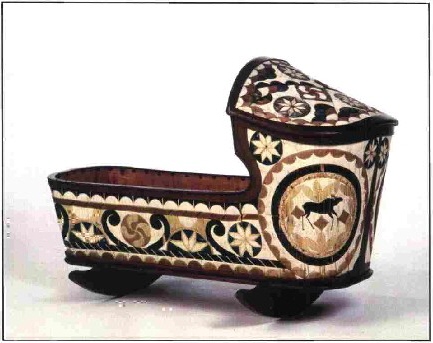 |

 |
 |

 |
.jpg)
Mary Christianne Morris (Paul)
(1804 - 1886)

NOTE:
The Morris cradle is a rare and fine example of mid-19th century extensive porcupine quillwork on birch bark panels. It presents many traditional symbols and motifs popular with the Mi'kmaq.
I visited the Museum on June 18, 2005. The only fitting word I can think of to describe the beauty of Christianne’s quillwork Cradle creation is MAGNIFICENT!!! Daniel N. Paul
PAUL, MARY CHRISTIANNE (Christina, Christy Ann) (Morris), Micmac artist and artist’s model; b. c. 1804 in Stewiacke, Colchester County, N. S., or Ship Harbour, Halifax County, N. S., daughter of Hobblewest Paul; d. 1886 in Halifax, N.S.
As a young girl, Mary Christianne Paul married Tom Morris, a Micmac of McNab Island, Halifax; he was considerably older than she, and an invalid for most of their married life. They had no children, but did adopt an orphaned niece, Charlotte, and a boy, Joe. Mrs Morris did exquisite work in the traditional Micmac crafts, supporting her family by the sale of quillwork and basketry. Her needlework, quillwork, splint basketry, and a full-sized canoe and paddles all won first prizes at various provincial exhibitions and she once sold two beaded costumes to Indian Commissioner William Chearnley for the impressive sum of $300. In 1854 she was living in Dartmouth, N.S., and a year later had moved across the harbour to the Northwest Arm, Halifax. There, “by her own industry,” she built and furnished a green frame house and kept a few farm animals. When her niece married in 1857, Mrs Morris served wine and cake to a large crowd, and provided flute and violin music. Accounts of this ceremony describe her as “a lady well known and respected in this community,” as indeed she was. Samuel and William Caldwell, mayors of Halifax, and Chearnley, the Indian agent, were her personal friends.
In 1860 a portrait of Mrs Morris by William Gush was presented to the Prince of Wales by the city of Halifax; it was a copy of one by the same artist which hung in her home. In it she is seated on the ground and wearing her self-made native costume which consisted of a beaded, peaked hat, a jacket, a woollen skirt appliquéd with ribbon, and beaded moccasins. She was evidently a favourite artist’s model: known portraits include the two identical oils by Gush done in 1859, entitled “Christina Morris”; an undated watercolour, “Christy Ann,” attributed to William Valentine; and an undated drawing attributed to Rebecca Crane Start, also entitled “Christy Ann.” A pastel of a Micmac woman, done about 1850 by an unknown Nova Scotia artist, is of either Christianne or her niece Charlotte. Four Halifax photographers did studio portraits thought to be of Mrs Morris, in two of which she holds examples of her quillwork. Only two works of art by Mrs Morris herself have survived: a pair of snowshoes, woven in fine mesh for a mayor of Halifax, and her now-famous cradle panels done about 1868. The birch-bark panels are decorated with coloured porcupine quills in the Northern Lights, Starfish, and Fylfot motifs, on a white quill ground. Central designs are two moose, worked in black quills, a type of realistic motif rare in Micmac quillwork. The panels comprise the largest single piece of Micmac quillwork in existence, and show her to have been a master quiller.
Christianne Morris has been called “a pious woman of excellent character.” By hard work and determination she took her family from life in a wigwam to a settled, middle-class existence. From the portraiture and works which survive her, she was also beautiful and gifted. One of Halifax’s most interesting citizens in the 19th century, Christianne Morris is remembered not only as a model for the Nova Scotia painters who portrayed her but as a talented artist in her own right.
The Nova Scotia Museum (Halifax) possesses the snowshoes made by Mrs Morris and her quilled cradle panels are in the DesBrisay Museum (Bridgewater, N.S.).
Nova Scotia Museum, Accession books, 2, nos.4591, 4603; Harry Piers, “Uncatalogued notes on Micmac genealogies and biographical material”; “Uncatalogued notes on Morris porcupine quill cradle.” PANS, MG 15, 6, no.1. Nova Scotia Industrial Exhibition, Official report of the executive committee . . . (Halifax), 1854. Provincial Agricultural and Industrial Exhibition of Nova Scotia, Prize list and report of proc. . . . (Halifax), 1868. Evening Express (Halifax), 4 July 1859. Halifax Morning Sun, 21 Aug. 1857, 4 July 1859. Novascotian, 24 Aug. 1857. R. H. Whitehead, “Christina Morris: Micmac artist and artist’s model,” Material Hist. Bull. (Ottawa), 3 (spring 1977): 1–14.